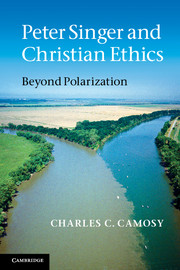Cmt.com blogger Charlie Camosy’s new book, Peter Singer and Christian Ethics: Beyond Polarization, was released this week in the U.K. and will soon be available in the U.S. If you are a fan of this blog, and share our desire for dialogue beyond right and left, you will love this book.
It reads like a wonderful extended conversation between a moral theologian committed to a consistent ethic of life and a philosopher whose views on God, abortion, euthanasia, and ethical method are at odds with traditional Catholic positions. In fact, Camosy has debated Singer in real life (and sat down to dinner afterwards). He clearly respects Singer, even though he knows some of their most fundamental disagreements will never be resolved.
Yet, ever-committed to making friends of would-be enemies, Charlie manages to find significant overlap between Singer and Catholic social teaching, especially in their shared rejection of moral relativism, high valuing of human life, and affirmation of the duty to sacrifice for the good of others. The chapters on food and poverty are particularly compelling. Charlie not only shows how Singer and Catholics have more in common than they think, he uses Catholic social teaching to show where Singer’s thought might be improved, and shows how Singer’s arguments could help CST develop more radical and specific positions.
When reading Singer’s work on food ethics and and poverty, I have often wondered why Christian Ethicists weren’t the ones making such powerful arguments. Now Charlie is doing just that.




Thanks for writing about this book, it is something I find fascinating, and will be interested in reading. When I read Singer in the past, I disagreed with his opinions so much that I could not consider what he brought to the conversation, and I dismissed his work. As a Catholic who also believes in a consistent ethic of life, finding common ground with Singer would be interesting. His arguments are compelling and make sense logically, but often lack the faith component which is where I struggle with his conclusions. I look forward to learning more about Singers’ other arguments and how they can connect to Catholic teaching.